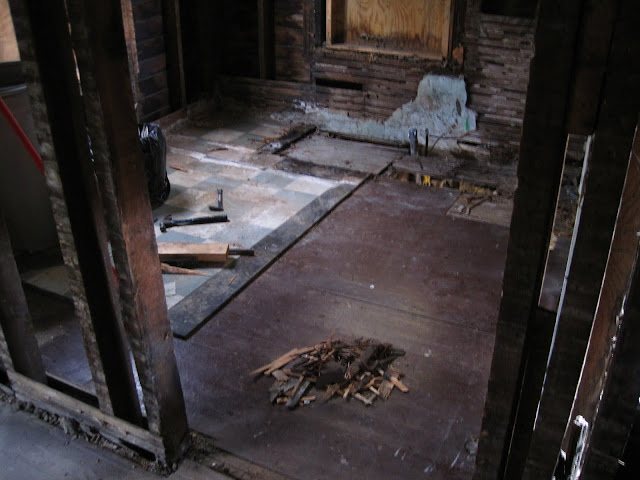After many delays and much much work, the house is finally free of it's plaster cast. All said, I hauled just shy of 15,000 pounds of plaster to the landfill (14,940 to be exact according to my landfill receipts). I'm quite happy to be relieved of that heavy burden. My next major landfill contribution will be the three layers of asphalt shingles on the roof and the 2000-or-so square feet of asbestos cement siding. I feel okay about this because, as I read on the side of the Waste Management (WM) refuse truck this morning - "WM's landfills provide over 17,000 acres of wildlife habitat". So, I'm actually helping the planet by throwing things away!
Actually, there's really just no other choice. I find it fascinating that in such a supposedly "advanced" society we still have not come up with a better solution that just throwing billions of tons of (often hazardous) waste in enormous holes in the ground and covering it back up. Recycling is a good start but ultimately industrial society should not produce anything that has to be disposed of in a hole in the ground (unless it's safe enough to eat). On second thought, we ought to
only be producing and using products that can be
safely thrown in a hole in the ground without permanently contaminating the water and soil.
The century-old plaster itself is fairly inert (consisting mainly of lime, horsehair, and sand) and could have been used as fill in the backyard (saving me countless hours of hauling and hundreds of dollars) but for the many layers of lead paint on it's surface. Come to think of it, with the notable exception of large quantities of lead paint on the interior walls and exterior clapboards, this house, as it was originally built, was a very healthy house - the foundation is local sandstone, and the rest of the house was built entirely of real wood (as opposed to modern particle boards and plywoods which contain toxic glues, binders, and preservatives) fastened with square cut steel nails. Even the original roof was cedar shingles over 1 by 8 pine sheathing (no asphalt underlayment). If the home's creators had chosen instead to use non-toxic milk (casein) paint rather than lead paint my experience now, a hundred years thence, would be vastly improved.
I'm making every effort as I rebuild this house to minimize it's future landfill burden. I'm planning for the roof to be steel since it's made with recycled metal, lasts a long time, and is 100% recyclable when it's eventually removed. I'm leaning toward cedar shingles for the siding if I can find a manufacturer that sources their wood from genuinely sustainable forestry operations (this will be tough). Untreated cedar shingles are non-toxic, and at the end of their useful life can be burned for firewood or just left in a heap to decompose without contaminating the soil and water (as long as no-one applies toxic stain to them). I would love to re-plaster the interior using clay/lime/straw plaster rather than the now ubiquitous standardized industrial modern wall-covering of choice - drywall. If so I can even re-use the wood lath that held the original plaster in place.
In any case, I hope to rebuild this house as a structure that can give many more years of comforting shelter and when the time comes, either gracefully decompose to nourish the surrounding soil or be be deconstructed and laid to rest without causing harm to either those working to disassemble it or to the land that will be it's final resting place.




















